BMW have upped their superbike game with the new S 1000 RR. Featuring significant upgrades and more advanced electronics, the 2023 machine will have the competition worried, especially in terms of its track performance. We headed to Almeria in Spain to see if the new S 1000 RR can make you ride like Scott Redding or at least make you feel like you can.
Story: Adam Child ‘Chad’
Photography: BMW
The RR adopts the steering geometry, adjustable swing-arm pivot, and ride height adjustment of the M-Sport, plus a few more top-end horsepower from the excellent ShiftCam engine along with a pair of distinctive aero wings. Electronics have taken a significant step forward with a new DTC Side Control, MSR engine brake torque control system, BSA Brake Slide Assist, ABS Pro, cornering ABS for use on track with slicks fitted, and even an ABS Stoppie feature; see, the Germans can have fun. Many of these new features are due to the new steering angle sensor.
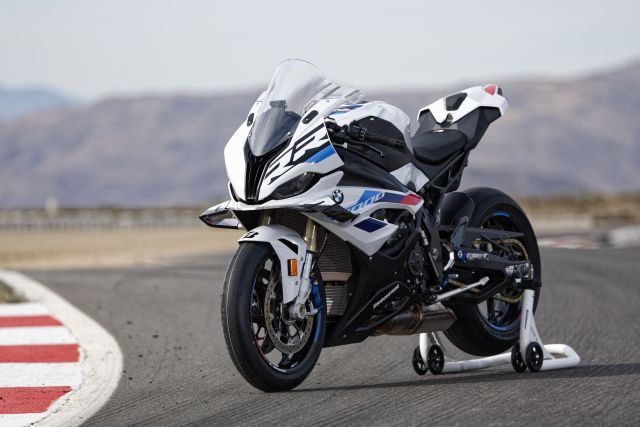
Changes in the chassis are not dramatic and essentially borrowed from the proven M 1000 RR. The S 1000 RR also gets the M chassis kit, with an adjustable swing-arm pivot point, while BMW have revised the rear shock and 45-millimetre upside down (USD) forks for 2023. As fitted to our test bike, electronic damping adjustment is an optional extra with the “Dynamic Damping Control” (DDC) package (Dynamic Package: heated grips, cruise control, dynamic damping, riding modes pro for £1,400 = Rs 1.4 lakh), altering the suspension settings to suit the selected riding mode.
Quoted weight remains the same, 197 kilograms fully fuelled for the standard bike, 195.4 kg with the optional “Race Package” that adds forged alloy wheels instead of die-cast rims, and 193.5 kg with the “M Package” option that swaps them for lightweight carbon wheels, which were fitted to our test bike (M Pack: carbon wheels, “M” colour, “M” seat for £4,480 = Rs 4.48 lakh).
The Flex Frame uses the engine as a stressed member, the wheelbase has increased and chassis dimensions are more relaxed, and the steering head angle is shallower, again very similar to the M 1000 RR. Wing appears for the first time, generating up to 17.1 kg of downforce at 300 km/h, 7.6 kg at 200 km/h, and 11.9 kg at 250 km/h. We had the advantage of perfect conditions in southern Spain in Almeria as well as pre-heated Bridgestone slicks. BMW fitted the M-Sport carbon wheels and set the DCT suspension to match the high-grip tyres and track temperatures. Conditions could not have been better.
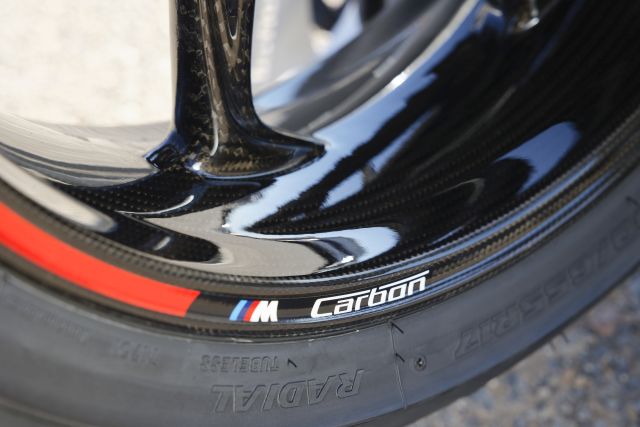
The changes are not huge but are significant. Within a few laps, you feel at home on the S 1000 RR; like a bike you have been racing all season. You immediately click and understand how the new chassis relates to the rider. The BMW is not a sharp and cut-throat sports bike as its aggressive “winged” look suggests. Instead, it is its ease of use that shines. The steering is sublime: look where you want to be and you are there. Apexes are hit with perfect accuracy lap after lap and with minimum effort. You do not have to force it; every input is met with a willing and natural response.
Mid-corner grip and feedback are excellent and body position changes do not appear to upset the chassis or grip. Get on the power early and instead of drifting wide, the BMW continues to hold a line as if it is in an invisible berm.
Stability, too, is impeccable. Towards the end of the Almeria lap there is a tight chicane where you make some time by clipping or riding over the kerbs. In the morning session I was hitting the kerb harder and harder, leaning over further, even braking deep over the first kerb, yet the S 1000 RR never skipped, slid or showed any indication of misbehaviour. It was almost comical how hard I was hitting the kerbs without a murmur of irritation from the suspension.
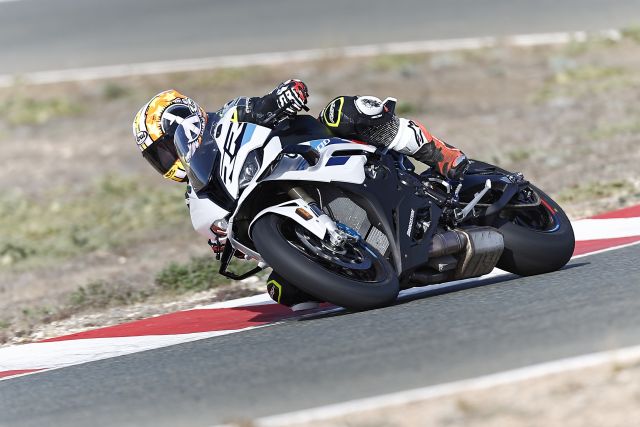
With the large TFT dash reading just over 280 km/h at the end of the straight, high-speed stability was not in question either. The new, larger screen takes most of the wind blast, so you can get tucked in, relax, and release your grip from the bars, which remain unflappable. It is hard to be certain but this may in part be down to the new aerodynamics as well as to chassis changes such as a longer wheelbase.
ABS Pro is new for 2023 and is essentially cornering ABS designed to work with slick tyres (with optional Pro mode). Combine that with the new MSR engine brake control and Brake Slide Assist (BSA) (in optional Pro mode) and it is a formidable braking package. It is amazing what you can get away with and almost takes the calculation of braking out of the rider’s hands; it is that good. The ABS Pro is designed to work with slick rubber and allows you to brake breathtakingly deep and late without fear of locking the front tyre.
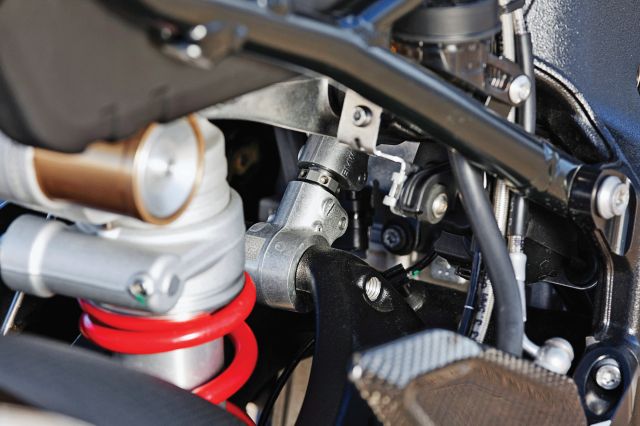
The new BSA works with the ABS and the MSR and is for track use. The clutch must be engaged, revs need to be high, and deceleration needs to be rapid. This new clever system works with the new steering-head sensor, plus other parameters such as brake pressure, again information from the six-axis IMU. The system, which features a new steering-head sensor and draws on parameters such as brake pressure, can calculate how much you are steering into a slide when braking heavily and the rear end starts to come around or “back in”. It took me most of the day before I could jump on the brakes (front and rear) and allow the system to bring the rear back in line with the front. I am no World Superbike Championship rider and it took me a while to activate the system and then trust it. However, when the system kicks in, it is impressive.
The updates which will have the competition worried are the introduction of the “Slide Control” function which allows the rider to pre-select one of the two possible drift angles that can be achieved before the Dynamic Traction Control system intervenes. The clever system uses the aforementioned new sensor on the bike’s steering angle to work out how far out of line the rear wheel is. The BSA uses the same sensor, along with other data, including information from the IMU. In theory, you can now truly power-slide and steer from the rear.
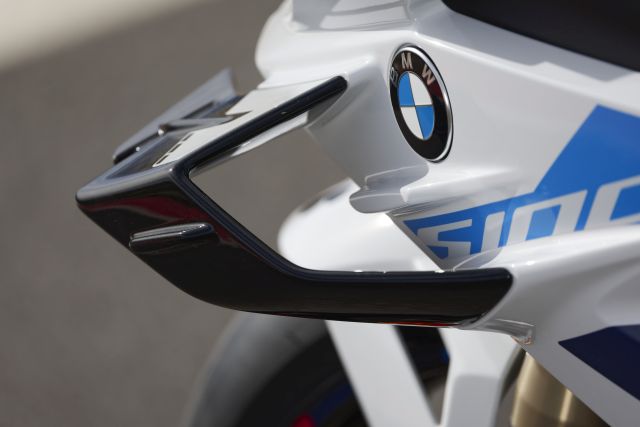
I suppose this will be relevant or useful to only a small number of riders. For starters, you have to turn down the DTC (traction control) enough to get the rear spinning because you cannot power-slide unless the rear is spinning and has lost grip. To make a rear Bridgestone slick “let go” in perfect conditions in sunny Spain requires skill and bravery and, after six long sessions on the same rear tyre, I still do not think I managed to provoke a true power-slide that activated the system. Nevertheless, it is nice to know it is there when that mistake does occur and the rear does start spinning; perhaps, after clipping a kerb or just giving it too much on a worn tyre.
BMW have improved the Shift Assistant Pro quick-shifter for 2023, too, making for smoother shifts, and even added a purpose GoPro mount on the rear seat unit. Torque remains unchanged at 113 Nm at 11,000 revolutions per minute (rpm) but they have added an extra tooth to the rear sprocket to give the sensation of more drive. Peak power is up a fraction: 210 hp. Peak power is higher up the rev-range at 13,750 rpm, just 250 rpm higher. It is not a massive jump in power, but it did not need to be.
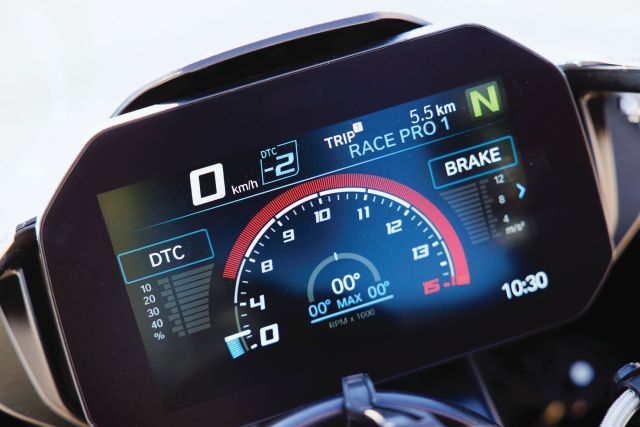
I am sure the clever Germans could have matched or even bested their superbike rivals but, frankly, the S 1000 RR did not need any more horses in the first place. The slight increase will only be noticeable when ridden back-to-back with the now old bike, while the change in the final gearing is more noticeable, making for quicker acceleration. The ShiftCam engine is the key element in the BMW’s overall package and ensures the S 1000 RR is ultra-versatile. The S 1000 RR shares the same engine and power and torque curves as the naked M 1000 R, albeit with different gearing, and is able to pull from 50 km/h in sixth gear to an indicated 280 km/h on Almeria’s long straight. And it is still pulling strongly when I go for the brakes.
Engine performance on track is incredible but very similar to that of the old bike. Power delivery is anything but peaky; you do not need to be in the last 20 per cent of the rev-range to make things happen. Instead, the RR pulls cleanly through its mid-range and you can even afford to short-shift to give the electronic rider aids an easier time. Equally, you can bounce the S 1000 RR off its soft rev limiter and make it scream.
The fuelling is excellent, among the best I have ever experienced on a 1,000-cc sports bike. You can be so precise with the throttle, getting on the power sooner and sooner. There is no snatchiness, which gives the rear tyre an easier life and allows you to accelerate progressively, feeling the grip.
The usability of the motor, backed up by new and advanced rider aids, means you can use every horse in the stable and nothing goes to waste. For a 210-hp rocket, the RR is incredibly easy to use and probably the least intimidating bike in this class. I will take a usable 210 hp over a peaky 230 hp all day long.
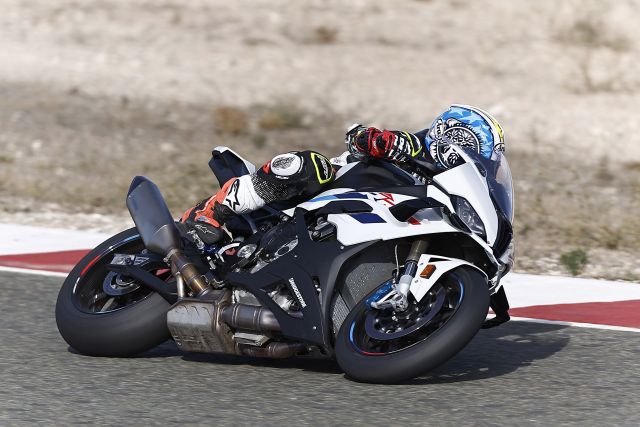
We did not manage any road miles during this first ride but the Dynamic Damping Controlled suspension allows the suspension to change automatically for road conditions and, despite its track capabilities, cruise control, heated grips, and even hill control are still available. You could even go one stage further and fit genuine luggage from BMW.
The rear seat unit is new, with the integrated GoPro mount, but the seat height remains the same at 824 millimetres. We obviously did not test fuel consumption on track, but BMW’s official fuel consumption numbers for the S 1000 RR remain unchanged for 2023: 15.7 km/l under WMTC conditions.
The 2023 BMW S 1000 RR is not tremendously different from the already excellent 2022 machine. Power has only gone up a few hp, the final gearing has changed, while on-paper performance is or should be about similar to that of the old bike… But that does not tell the full story.
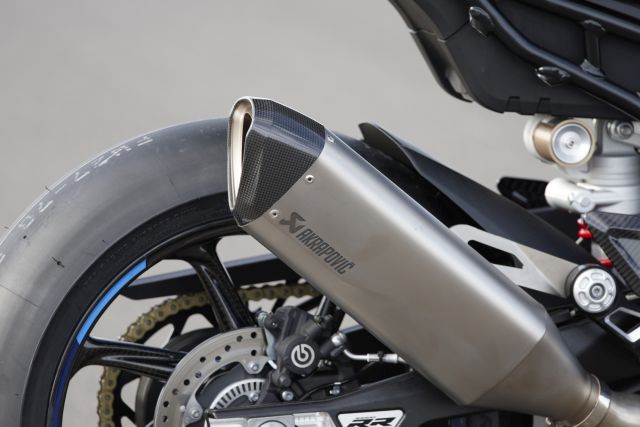
Fact is, the S 1000 RR did not need any more power. An impressive 210 hp is as much as necessary, thank you. What counts is usability and the ease of use of the horsepower it already possesses—and in this respect, the RR feels as friendly as a decent supersport 600. It is so unintimidating you can just jump on and thrash it.
The changes in the chassis, even the addition of new aerodynamic wings, are not ground-breaking, but certainly make a difference, depending on speed, and are proven as they work on the M-Sport. We had the ideal conditions in Spain on slick rubber but, wow, what a handling package. The chassis’ feedback, stability, and huge stopping power are astonishing. It is so easy to pilot, you can cut fast laps all day long without feeling you have done a few rounds with Mike Tyson. You never feel as if you are in a fight with 200-plus hp; only that the RR is working with you.
The new electronic rider aids have upped the Beemer’s game to the point they are not merely on a par with the competition, but arguably above. Some of the rider aids may only appeal to highly skilled riders, but the traction control is superbly effective and the updated quick-shifter is as near as dammit perfect. The engine, chassis and rider aids are so good, and it is so rewarding and easy to ride, the RR really feels like a PlayStation game (albeit one that hurts should you get it completely wrong).
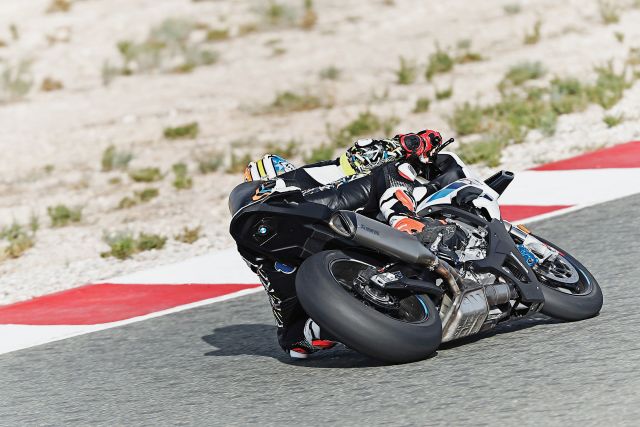
The big and obvious test will be when the Beemer goes up against the competition in this technologically advanced superbike category. Honda’s Fireblade is a proven race winner on the track, Ducati’s V4 Panigale has more power and stunning electronics, and do not forget Aprilia’s more powerful and sublime RSV4. It is going to be a close one.
But ridden in isolation, I am running out of superlatives for this very special BMW.
Technical Specification
Capacity: 999 cc
Bore x Stroke: 80 x 49.7 mm
Engine layout: Liquid-cooled in-line four-cylinder
Engine details: ShiftCam variable valve timing and lift, DOHC
Power: 210 hp at 13,750 rpm
Torque: 113 Nm at 11,000 rpm
Top speed: 303 km/h
Transmission: Six-speed, standard quick-shifter
Average fuel consumption: Claimed: 15.7 km/l or 6.4 litres/100 km
Tank size: 16.5 litres
Max range to empty: 257 km (claimed)
Rider aids: Cornering traction control and ABS, slide control, brake slide assist, riding modes, optional electronic damping control
Frame: Die-cast aluminium “Flex Frame”
Front suspension: 45-mm USD forks
Front suspension adjustment: Adjustable compression, rebound, and preload. Optional DDC electronic adjustment
Rear suspension: Underslung double-sided swing-arm with central spring strut
Rear suspension adjustment: Adjustable compression, rebound, and preload. Optional DDC electronic adjustment
Front brake: Twin 320-mm discs, four-piston radial calipers
Rear brake: Single 220-mm disc, single-piston caliper
Front Wheel: 3.50 x 17-inch, cast alloy (forged alloy or carbon optional)
Rear Wheel: 6.00 x 17-inch, cast alloy (forged alloy or carbon optional)
Front tyre: 120/70 ZR17
Rear tyre: 190/55 ZR17
Dimensions (L x W x H): 2,073 mm x 846 mm x 1,155 mm
Wheelbase: 1,457 mm
Seat height: 824 mm
Weight: 197 kg (wet)

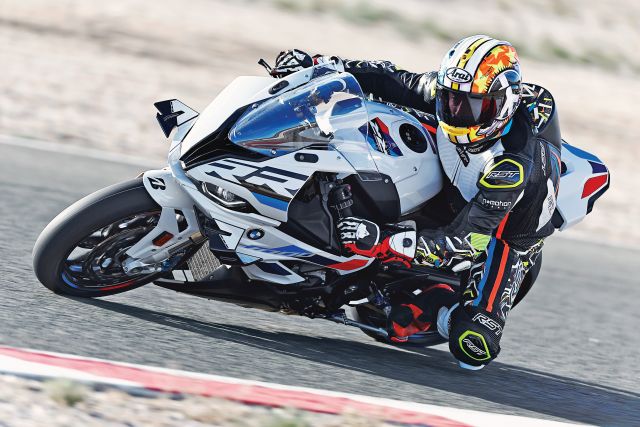

Leave a Reply